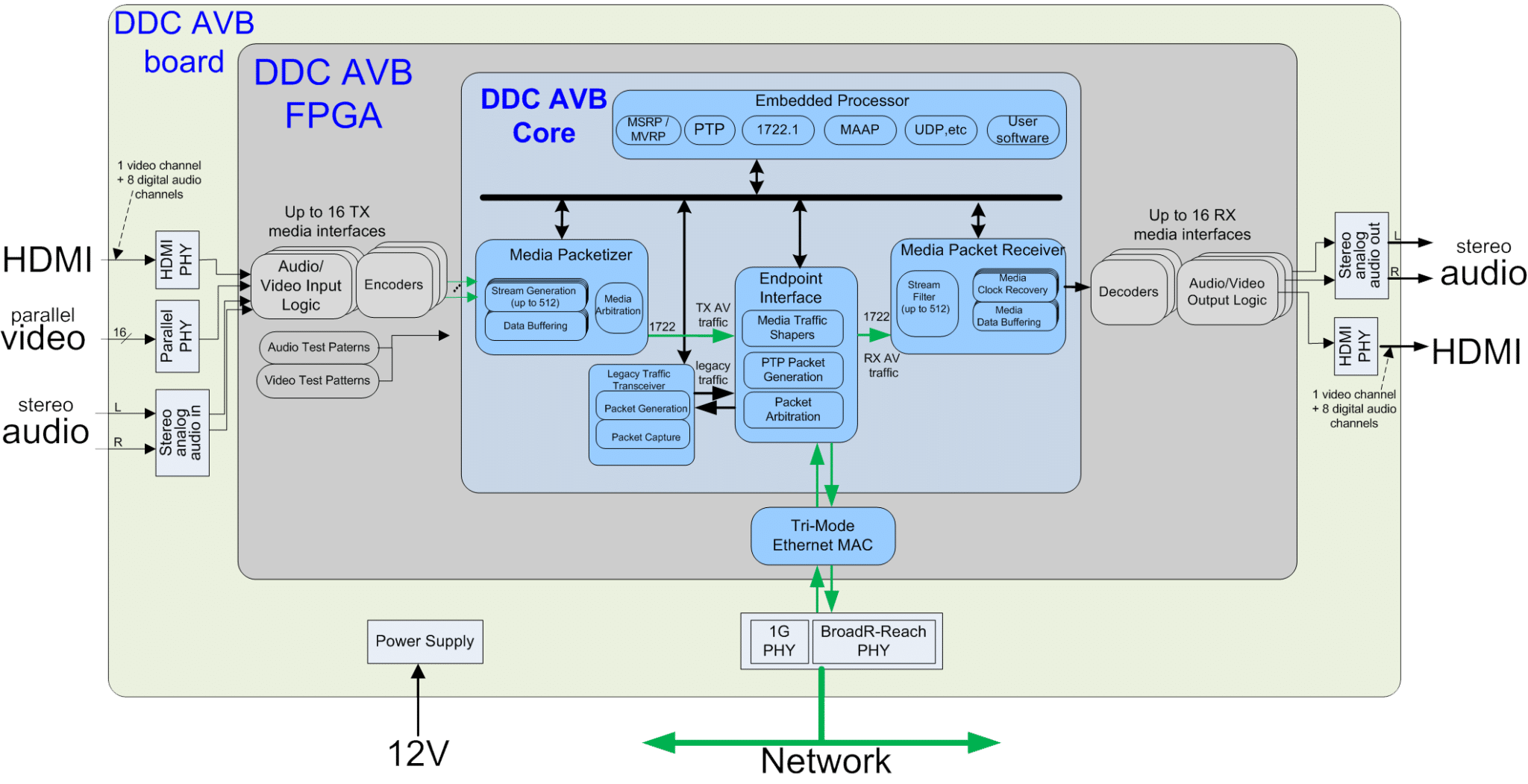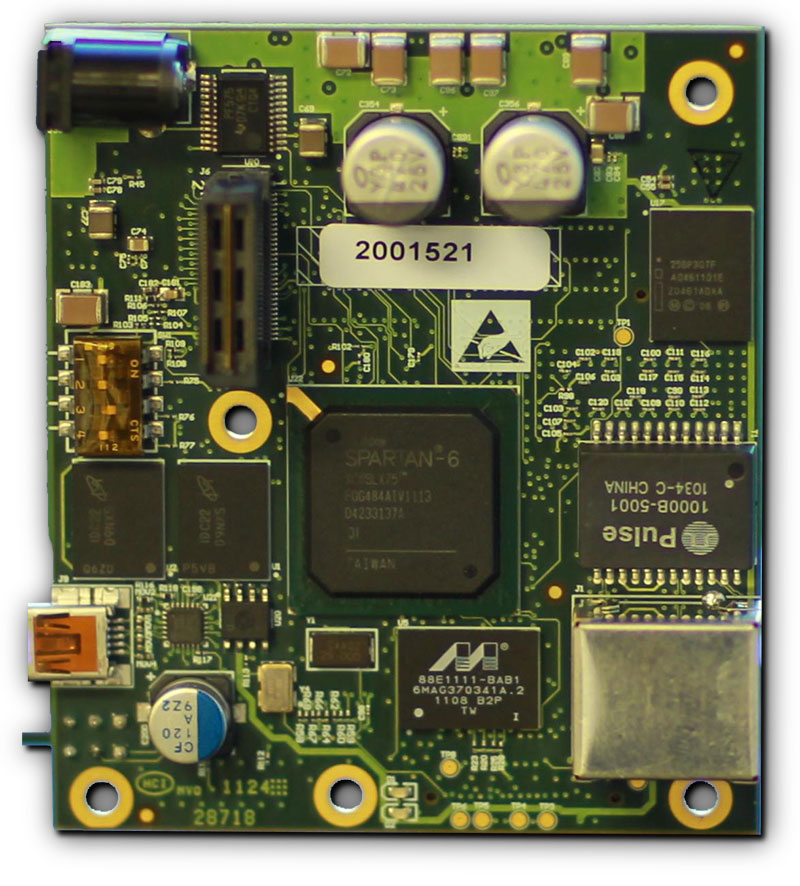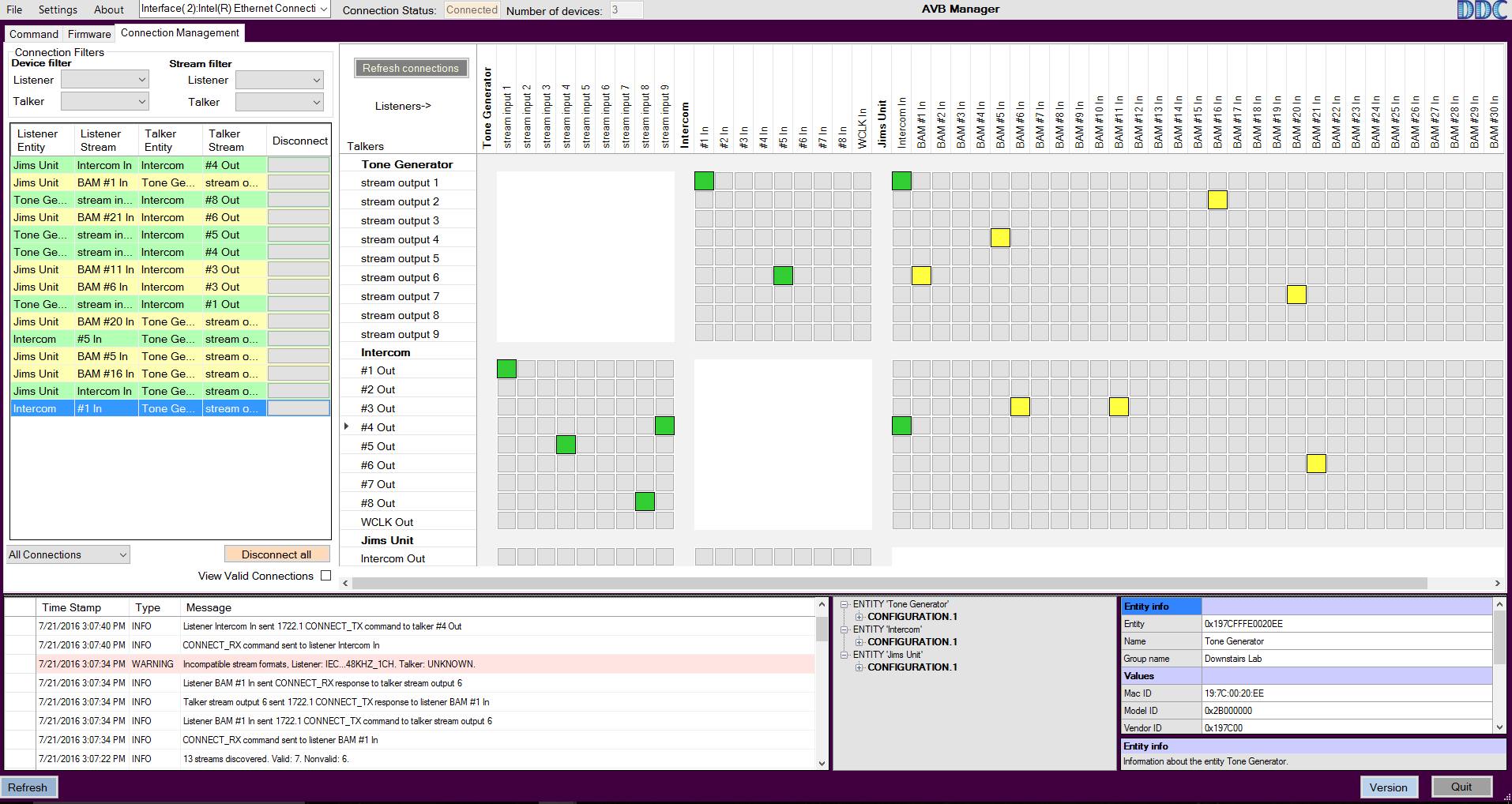The IEEE 802.1 Standards Committee (the main standards body in charge of most common networks) has developed the Audio Video Bridging / Time Sensitive Networking (AVB/TSN) set of standards to help existing networks carry time-sensitive data such as audio and video media streams. AVB/TSN (also known as Ethernet AVB) makes it possible to deliver high volumes of data, in real time, to multiple destinations, with very low latency. And, as an open standard, it allows devices of different manufacturers to interoperate with each other.
With Ethernet AVB/TSN, you can turn any machine or appliance into a network device, capable of communicating with other devices. In other words:
- Make any camera into a network camera
- Make any display into a network display
- Make any microphone into a network microphone
- Make any speaker into a network speaker
Any device connected to a network can become a plug-and-play appliance, and you can connect them all within the same system, even if from different manufacturers.
Advantages of AVB/TSN
Reliability
The precise timing of AVB/TSN enables synchronization of devices, allowing for deterministic, high-bandwidth, high-efficiency network usage. Using timing synchronization, an AVB/TSN-based system guarantees real-time delivery of data, with extremely low latency. This factor alone enables the development of time-sensitive control applications. Additionally, it guarantees an assured Quality of Service (QoS) for audio/video traffic, because audio video bridging sets aside up to 75% of bandwidth reservation on any given connection for time-critical data.
Simplicity
AVB/TSN enables system-level cost reduction, because it allows use of existing network cable and connectors already in place, and can also interoperate with legacy network traffic. Many different types of data, including media, control, and legacy traffic communications, can travel on the same inherently low-cost unshielded twisted pair (UTP) technology. Additionally, the robust standards of AVB/TSN support legacy protocols (TCP/IP, UDP, FTP, HTTP, etc.), and ultimately make any future scaling for network expansion simple and seamless.
Flexibility
AVB/TSN provides the ability to efficiently share media and data from a single source, or talker, with multiple receiving devices, or listeners. Additionally, the standards allow flexibility in network topologies, including star and star/tree configurations, just like conventional networks.
Applications
Many industries have adopted AVB/TSN technology to leverage significant benefits from their network, especially for time-critical needs, including the following:
- Pro audio, such as performance venues and broadcast applications
- Pro video, such as television networks
- Automotive in-cabin entertainment
- Automotive ADAS (Advanced Driver Assistance Systems) applications
- Military vehicle situational awareness and response
- Aircraft video and audio distribution
- Naval video and audio distribution
- Manufacturing synchronization of high performance machines
- Closed loop control applications
- Critical robot and drive control systems
- Safety and optimization for utilities, oil, gas, and transportation
DDC can help you convert your digital network into an integrated audio-visual network, and take advantage of the reliability, flexibility, determinism, power, and simplicity of audio video bridging. DDC offers solutions as IP cores, chips, and circuit boards, as well as consulting services as-needed to help you reach your goals.

DDC Solutions
DDC can offer full support in the following forms:
- IP-only, with documentation and support
- Turn-key chip (FPGA and software)
- Turn-key DDC small AVB board
- Turn-key custom board, tuned for your needs (including turn-key chip)
- Full prototype and production services
- Certification assistance
DDC solutions include full compliance with IEEE standards:
- 802.1AS Precise Timing / Synchronization Protocol (PTP)
- 802.1Qat Media Stream Reservation Protocol (MSRP)
- 8021Qav Forwarding and Queuing for Time-Sensitive Media Streams (FQTSS)
- 1722 Transport Protocol for Media Streams
- 1722.1 Discovery, Enumeration, Connection Management, and Control
- MAAP MAC Address Acquisition Protocol
IP Cores
Based on hardware acceleration and man-years of sophisticated engineering effort, DDC IP cores provide UNH-certified solutions that allow clients to move rapidly into AVnu Certification with cutting edge products, and speed up their time to market with confidence. With all the fundamental operations of AVB/TSN, IP cores enable clients to:
- Offer products that use standard Ethernet cabling or BroadR-Reach solutions
- Complete affordable, simplified installations
- Benefit from GUI level control over connections
- Interoperate with other AVnu certified products (may require interoperability system testing and support)

DDC-AVB-EP-DK

AVB/TSN Endpoint Development Kit
DDC offers highly customizable AVB/TSN solutions, designed to support large scale, advanced AVB/TSN networks within subnets. With both audio and video support, DDC offers:
- Full Listener and/or Talker Support
- Media Clock Recovery
- Stream-Based Credit Shaper
- Port-Based Credit Shaper / Arbiter
- Packet Filtering
- Media Encapsulation
- Uncompressed 48kHz Stereo Audio (Up to 90 Streams per Network Port)
- Low Latency: 2ms Max Delay for Class A Traffic
Field-Programmable Gate Arrays: An AVB/TSN Powerhouse
DDC uses Field-Programmable Gate Arrays (FPGA) in conjunction with a processor for processing power, which offers many distinct advantages over the alternatives.
ASIC / Standard Chip
An ASIC presents some limitations in supporting AVB processing capabilities. First, not many exist. This solution of “hardening” functionality into an ASIC carries risks, since the AVB/TSN arena continues to exhibit rapid growth. Also, peripheral functions that normally surround AVB/TSN applications have proven ripe with activity. Full integration requires a complete up-front design effort to properly include all the needed functionality, which will become an issue as the AVB/TSN standards continue to evolve. However, this solution can ensure a low latency for data streams, hardware acceleration, and low-cost production. Additionally, while you can implement a high number of channels, a standard ASIC chip may not support new features, protocols, codecs, or surrounding support functions for audio or video. Bottom line, a standard chip carries the danger of quickly growing obsolete.
Processor Only
For the processor-only solution, any design will face limitations in support for current and future codecs and other functions, depending on the processor capability and performance. In addition, the design cannot achieve the same hardware-accelerated performance or low latency of other solutions, nor the ability to incorporate an extensible number of channels and peripherals. Finally, bandwidth limitations of this alternative will severely limit many video solutions.
FPGA with Processor
This solution gives you the best of both worlds. An FPGA with embedded processor offers the most robust solution for AVB/TSN systems. Different flavor FPGAs exist with same physical package size and pins, making them interchangeable. And, because of the flexibility of VHDL programming, the technology easily ports to suitably-sized FPGAs, enabling this solution to offer obsolescence protection and extensive support for current and future codecs, as well as other peripherals. Other key benefits include the ability to upgrade image and audio processing capability, high integration with limited impact, low latency, low cost, and the ability to upgrade in the field. Additionally, this design option can provide for robust audio and video support, an extensive number of channels, and extensive hardware acceleration.

AVDECC Controller / AVB Manager
DDC offers AVDECC Controller (an AVB/TSN manager as a PC application) for device enumeration, discovery, and control. It works with DDC’s AVB solutions or other AVB solutions. It makes designing, debugging, and configuring your AVB/TSN system easier and more productive.
Features:
- Discovers all AVB endpoints on the network
- Acquires, locks, or reboots any AVB endpoint
- Makes connections, connecting talkers to listeners
- Logs endpoints and stream info
- Highlights compatible connection possibilities
DDC-AVDECC

